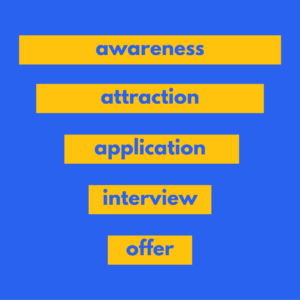The author of this blog post is Jenna Bunnell,
Senior Manager for Content Marketing at Dialpad, an AI-incorporated cloud-hosted unified communications system that provides valuable call details for business owners and sales representatives. Thanks for sharing your insights!
“Recruitment is marketing. If you’re a recruiter nowadays and you don’t see yourself as a marketer, you’re in the wrong profession.” – Matthew Jeffrey, Global Head of Sourcing and Employment Branding at SAP.
This attitude toward recruitment is becoming the standard and with good reason. There are so many applicants with a wide variety of skills; it can be a huge challenge for human resources departments to attract the right candidates to roles and narrow down the pool.
To help streamline the whole process, many companies are implementing a recruitment funnel framework – a systematic, marketing-minded approach to hiring aimed to increase business efficiency and find the best candidates.
What Is a Recruitment Funnel?
It’s a simple, easy-to-use model to help employers find the best possible candidates for a position, and guide them through the recruitment process.
Most have around five steps, laid out like this:

Here, we’ll look at each step more closely, along with some essential metrics or key performance indicators so your recruitment team can assess how well they’re performing each step.
Awareness
This is where the marketing side of things comes into play. Building a brand for consumer demographics is a familiar practice. Awareness shares much of the same principles; however, you’re now considering applicant demographics.
Think about the kind of candidates you’d like to attract and what might attract them to work for you. If you’re not sure, ask existing employees what they like about your company and let those qualities shine through in your branding.
Attraction
This boils down to two main elements – where and how you advertise open positions.
You should have a careers page with a full list of openings and links to applications. There are also a host of job sites that will advertise openings on your behalf.
How you advertise is a little more difficult, and it’ll depend entirely on the applicant you’re trying to attract. Make sure the job description is well-written, comprehensive, and well-formatted – a solid block of text will not attract anybody.
Be transparent with important information like salary and hours – Listing a $40,000 annual salary sounds great, but if you don’t mention that it’s pro-rata until the career page, it may appear dishonest. Offer open lines to your company’s email and business phone system, so they can get in touch if they have any questions.
Application
This is where the marketing tactics have paid off, and applications start coming in. You’re going to want to make this as stress-free as possible.
This doesn’t necessarily mean you should lower your entry requirements; you could just make the physical act of applying quick and painless.
It should take around 10 to 15 minutes to apply – any longer, and you’re probably overcomplicating things.
Application pages should be compatible on mobile devices (phones and tablets), and automated application emails are always a good idea to let the candidate know their application has been received.
Interview
So, you’ve cast out your recruitment net, selected suitable applicants. Now, for the interview process. There are a few key bases to cover before the interview process.
Decide On the Format of the Interview
Will you interview candidates as a group or individually? Group interviews are great for assessing candidates’ behavior in an unfamiliar setting and their team tasks management skills. But it can be difficult for the interviewer to keep track of everything that’s said and by whom if the group is quite large.
On the other hand, individual interviews are an opportunity to get to know the candidate on a more intimate level and ask more specific questions.
Many companies use a mixture of the two at different stages of the interview process because people behave differently in different situations.
Assemble a Hiring Team
Using multiple members of staff with different areas of expertise is a great idea. Some will notice things you’ve missed and find value in candidates that others may overlook.
Communication
Covid-19 has all but eliminated the face-to-face interview – the hours of practicing the perfect handshake have now gone to waste. Instead, most interviews now occur via phone or video conferencing software, so video and call quality are essential.
Interview situations are stressful enough without patchy connections. For larger companies, enterprise phone systems will prevent poor coverage.
Sometimes, however, it’s unavoidable. The only thing you can do is run tests to make sure your connection is strong and find the best communication software available. Don’t be afraid to shop around for a Zoom phone alternative that might better suit your needs.
Follow Up
Decide if there will be follow-up tasks for your candidates. Don’t make it anything too strenuous. This is essential to see how your candidates respond to a given assignment and weed out those who aren’t that interested.
Offer
Finally, you get to hire somebody. Remember – it’s more than just a “welcome aboard”. There are still a few crucial parts to this step.
First of all, your recruitment team needs to decide on a candidate. This is obviously a huge decision, but try not to take too long – your candidates are more than likely pursuing other jobs in the meantime, and you don’t want to miss them.
You’ll then have to negotiate a contract with your chosen candidate; salary, vacation, hours per week, and benefits. Again, don’t draw this step out too much. There’s nothing wrong with playing a little bit of hardball, but being too HR-forward can sour the relationship before they’ve even started.
5 Essential Metrics
As you work through each level of the recruitment, you can see how well you’re performing each step using these five essential metrics:
- Awareness
- Hits on your careers page
- Search engine results for your company
- Attraction
- Conversion rates – how many of those who viewed the job description actually applied?
- Application
- Conversion rates – how many of those who began the application actually completed it?
- Interview
- Post-Interview surveys
- How many applicants were suitable for the interview?
- How many of those continued after each interview stage?
- Hiring
- How many candidates accepted offers?
- How long did this step take?
Remember
The recruitment funnel is both for the benefit of the recruiter and the candidate. It’s a streamlined process to help both parties get what they need. There’s even dedicated recruitment software to keep the recruitment funnel running smoothly.
So, keep these points in mind at every stage, use these metrics to see how you can improve, and you’ll find the best people for the job every time.


